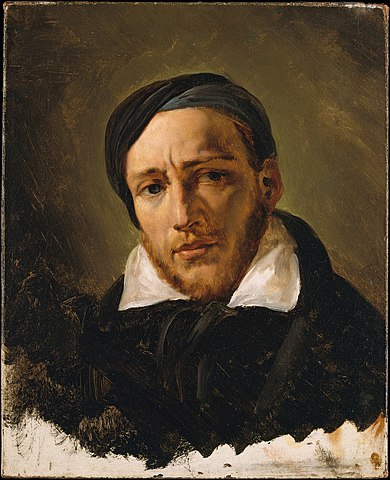
Born: 26 September 1791, Rouen
Died: 26 January 1824 (aged 32)
Period: Romanticism
The Life of Théodore Géricault
Théodore Géricault was a pivotal figure in French Romanticism, known for his powerful and emotive works that broke away from the neoclassical traditions of his time. Born in Rouen, France, Géricault’s passion for art emerged early, leading him to study at the prestigious École des Beaux-Arts in Paris. His style evolved through the influence of earlier masters like Michelangelo, Caravaggio, and Peter Paul Rubens, as well as contemporary artists such as Antoine-Jean Gros.
Early Career and Influences Géricault’s early work was marked by a fascination with the dynamic and the dramatic, as seen in his choice of subjects that often depicted scenes of action and intensity. His studies with Pierre-Narcisse Guérin and subsequent visit to Italy further enriched his understanding and appreciation of Renaissance art, which significantly influenced his development as a painter.
The Raft of the Medusa Géricault achieved early fame with his monumental work “The Raft of the Medusa” (1818–1819), a dramatic and poignant portrayal of survivors from the wreck of the French naval frigate Méduse. This painting, now housed in the Louvre, is celebrated for its raw emotional power and complex composition, marking a departure from traditional historical painting. It not only illustrated a contemporary tragedy but also critiqued the French government’s incompetence, cementing Géricault’s reputation as an artist unafraid to confront social and political issues.
Later Works and Contribution Following the success and controversy of “The Raft of the Medusa,” Géricault continued to explore themes of human struggle, suffering, and passion. His later works include a series of portraits of the insane, which are remarkable for their empathetic and psychologically nuanced portrayal of mental illness. Géricault’s interest in motion and anatomy also led him to produce numerous studies of horses and equestrian subjects, showcasing his remarkable skill in capturing the vitality and movement of his subjects.
Despite his short life, Géricault’s impact on the Romantic movement and French painting was profound. His bold experimentation with composition, light, and subject matter opened new avenues for emotional expression in art. Géricault’s works are characterized by their dramatic intensity, a deep sense of humanity, and a relentless pursuit of authenticity, making him a forerunner in the Romantic movement in art.
Death and Legacy Géricault died in Paris at the young age of 32 due to complications from a riding accident. His death was a significant loss to the art world, but his legacy lived on, influencing subsequent generations of artists, including Eugène Delacroix and the Realists. Géricault’s passionate commitment to depicting the human condition, combined with his innovative techniques, continue to inspire admiration and study, securing his place as one of the key figures in the history of Western art.
Théodore Géricault’s Notable Works
Théodore Géricault, a towering figure of the Romantic movement, left an indelible mark on art history through his passionate and dramatic works. Here are ten of Géricault’s most famous and influential pieces:
- “The Raft of the Medusa” (1818-1819) – This monumental painting, depicting the aftermath of a shipwreck, is Géricault’s most famous work, renowned for its raw emotional power and complex portrayal of human despair and survival.
- “The Charging Chasseur” (1812) – An early work that already shows Géricault’s fascination with themes of motion and battle, capturing a cavalry officer in full charge.
- “The Wounded Cuirassier” (1814) – This painting highlights the aftermath of battle, focusing on a wounded soldier leaving the battlefield, and reflects Géricault’s interest in the human cost of war.
- “Insane Woman” (1822) – Part of a series of portraits depicting patients with mental illness, this work is notable for its sympathetic and psychological depth.
- “The Derby at Epsom” (1821) – Géricault’s fascination with horses is evident in this dynamic portrayal of a horse race, showcasing his ability to capture speed and movement.
- “Portrait of a Kleptomaniac” (1822) – Another in the series of portraits of the mentally ill, this painting is a haunting depiction that delves into the psyche of the subject.
- “The Plaster Kiln” (1822-1823) – Demonstrating Géricault’s interest in everyday labor and industry, this work captures workers at a kiln, highlighting the physicality of their toil.
- “Officer of the Imperial Guard” (1812) – This early portrait exemplifies Géricault’s skill in capturing the dignity and solemnity of his subject, with a focus on the detail of military dress.
- “The Blacksmith” (c. 1822-1823) – Reflecting his continued interest in labor and the working class, this painting depicts a blacksmith at work, emphasizing the physical strength and intensity of labor.
- “Study of Truncated Limbs” (1818-1819) – Part of Géricault’s anatomical studies, this work reveals his interest in the human body and his dedication to realism and accuracy in depiction.
Géricault’s oeuvre is characterized by a relentless pursuit of emotional intensity, a profound empathy for his subjects, and a fascination with the darker aspects of human existence. His masterful use of light and shadow, combined with his dynamic compositions, has cemented his legacy as a pioneer of the Romantic movement in art.